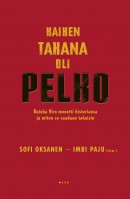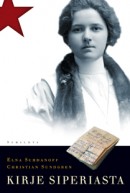Tag: history
Hannele Klemettilä: Keskiajan julmuus [Medieval cruelty]
6 November 2009 | Mini reviews, Reviews
 Keskiajan julmuus
Keskiajan julmuus
[Medieval cruelty]
Jyväskylä: Atena, 2008. 365 p., ill.
ISBN 978-951-796-517-0
€ 34, hardback
Darkness, cruelty, violence and ignorance are characteristics commonly associated with the medieval era. This book aims to show that this type of thinking contains a number of myths and misconceptions that have arisen in both scholarly and popular culture. She investigates how cruelty arose in medieval culture and society and how it was understood, as well as its antitheses: sympathy, fraternity and mercy. The focus of this study is from the 13th century to the first half of the 16th century. The author has relied on writings, art, folk tales and documentary sources from theoreticians, chroniclers and poets in her study. Particular attention is paid to those groups who represented the ‘non-human’ in medieval thinking, such as women and children, the infirm, common people and animals. This book also outlines a broader chronological perspective in its subject matter and addresses the issue of when the medieval era was labelled as being cruel and why that label has stuck. Hannele Klemettilä, a post-doctoral researcher at the Finnish Academy, is a cultural historian.
Kaiken takana oli pelko. Kuinka Viro menetti historiansa ja kuinka se saadaan takaisin [Fear behind it all. How Estonia lost its history and how it will be recovered]
23 July 2009 | Mini reviews, Reviews
 Kaiken takana oli pelko. Kuinka Viro menetti historiansa ja kuinka se saadaan takaisin
Kaiken takana oli pelko. Kuinka Viro menetti historiansa ja kuinka se saadaan takaisin
[Fear behind it all. How Estonia lost its history and how to get it back]
Toim. [Ed. by] Sofi Oksanen & Imbi Paju
Helsinki: WSOY, 2009. 563 p., ill.
ISBN 978-951-0-35111-6
€ 29, hardback
Twentieth-century Estonian history was marked by a brief German occupation (1918) and a Soviet occupation lasting nearly half a century (1940–1991). This book contains more than 30 articles by Finnish, Estonian, Russian, British and American experts in the field, dealing with with subjects that include the propaganda of the Soviet occupation, the methods of political oppression, environmental pollution, corruption and the situation of the arts and culture during the occupation. There are also previously suppressed memoirs and reminiscences by survivors of the Gulag prison camps. Sofi Oksanen (born 1977) is a Finnish writer of Estonian heritage who was awarded the 2008 Finlandia Prize for Fiction for her novel Puhdistus (‘Purge’), which is based on Estonian history. Imbi Paju (born 1959) is an Estonian film director and writer. The book deals with the morality of a totalitarian state in general, and examines how different contries have approached the concept of human rights violations in recent times. It has given rise to much debate about Finland’s relations with neighbouring Estonia and its people.
Elna Schdanoff & Christian Sundgren: Kirje Siperiasta [A letter from Siberia]
17 June 2009 | Mini reviews, Reviews
 Kirje Siperiasta [A letter from Siberia]
Kirje Siperiasta [A letter from Siberia]
Finnish translation by Paula Autio
Helsinki: Schildts, 2008. 233 p., ill.
ISBN 978-951-50-1783-3
€ 29, hardback
Swedish original: Brevet från Sibirien
Esbo: Schildts, 1997. 233 p., ill.
ISBN 951-50-0865-4
€ 29, hardback
Kirje Siperiasta is based on letters and memoirs covering a period of more than 80 years by Elna Schdanoff (Russian spelling Zhdanova, 1885–1977). Born in St Petersburg, Elna belonged to a Finland-Swedish family of industrial entrepreneurs in Russia. Her father was director of a Belgian mining and steel company, and after the revolution of 1917, her Russian husband Vadya Zhdanov became the first engineer in the Soviet steel industry. In the whirlwinds of the Revolution the Zhdanovs decided to remain in the Soviet Union. Vadya Zhdanov was executed as a spy during the Stalinist purges of 1938; Elna was sentenced to tens years of forced labour and deportation. According to the book’s editor, Zhdanova’s nephew Christian Sundgren, his aunt’s memoirs were not published in Finland when she wrote them because of the self-censorship of the Finnish press. In addition to the account of her imprisonment, the book generates interest with descriptions of Russian industry before and after the revolution. In the 1950s Zhdanova’s brother finally managed to obtain permission for his sister to travel to Finland where she remained for the rest of her life.
Henrika Tandefelt: Konsten att härska [The art of ruling]
27 March 2009 | Mini reviews
 Konsten att härska. Gustaf III inför sina undersåtar
Konsten att härska. Gustaf III inför sina undersåtar
[The art of ruling. Gustav III in the presence of his subjects]
Helsingfors: Svenska litteratursällskapet i Finland / Stockholm: Atlantis, 2008. 439 p., ill.
ISBN 978-951-583-159-0
€ 35, hardback
The book, based on Henrika Tandefelt’s doctoral dissertation (2007), explores the meaning of kingship in Gustavian political culture. King Gustav III (1746–1792), who ruled over Sweden and its ‘Finnish territory’ with his machinery of government officials, devoted himself to phenomena which have received little attention from historians. Complicated rules of etiquette, ceremonies, tournaments, and various genres of art were the object of much study on the part of the king, who had both ethical and political aims in meddling in these. Tandefelt examines topics like royal favours – the granting of noble ranks, and medals and titles – and the rhetoric used by the king. The final part of the book looks at Gustav III’s actions against Russia during the 1788–1790 war.
Sofi Oksanen: Puhdistus [Purge]
5 February 2009 | Mini reviews
![Sofi Oksanen: Puhdistus Sofi Oksanen: Puhdistus [Purge]](https://booksfromfinland.fi/wp-content/uploads/2009/02/puhdistusweb-130x164.jpg) Puhdistus
Puhdistus
[Purge]
Helsinki: WSOY, 2008. 380 p.
ISBN 978-951-0-33973-2
€ 29.90, paperback
Sofi Oksanen’s first play Puhdistus (‘Purge’) was staged at Finland’s National Theatre in 2007. Oksanen (born 1977) has an Estonian-Finnish background and studied at the Theatre Academy. Puhdistus, her third novel, retells the story of her play about two women and moves through the past by flashbacks between 1939 and 1992. Aliide has experienced the horrors of the Stalin era and the deportation of Estonians to Siberia, but she herself has to cope with the guilt of opportunism and even manslaughter. More…
No place to go
Issue 1/2008 | Archives online, Fiction, Prose
Extracts from the novel Lakanasiivet (‘Linen wings’, Otava, 2007)
The clothesline swayed in the wind. Helvi closed her eyes and felt herself flutter into the air with the laundry. She flapped her white linen wings, straining higher, now seeing below the whole small peninsula city, its damp rooftops glittering in the morning sun, the blue sighs of the chimneys, the steamboats toiling on the lake and the trains chugging on their tracks. The whole of heaven was clear and blue; only far off in the east were there white pillars roiling – whether smoke or clouds, Helvi could not tell.
She flew north on her linen wings and saw the great bridges leading to the city, on whose flanks the hidden anti-aircraft batteries gasped the fumes of gun oil and iron, and continued her journey over the land, following the straight lines of the telephone wires. She flew over wooded hills and deep green fields, finally arriving on the slope of the great hill where her daughter now lived, in hiding from the war. More…
On the make
31 December 2007 | Fiction, Prose
Extracts from the novel Benjamin Kivi (WSOY, 2007). Introduction by Lauri Sihvonen
Benjamin Kivi alias Into Penger, the 1930s
What was Kuihkä worth? What were this little man and his sons worth? What was I worth?
I drove where the little man told me to, with no lights, through a densely populated area. I could only see half a meter in front of me, trying to sense the bends and curves in the road and still keep Tallus’ car in good shape. When we got to the woods I turned on the lights and glanced at the little man sitting next to me. He was stuffing a handkerchief into his sleeve like an old housewife. The top of his head was sweating. He brushed his hair back and shoved his cap down on his head.
I had two hours to think as I drove, but it felt like a few minutes. If I didn’t drive the car, someone else would have, everything would happen just like the little man had planned, and I wouldn’t know anything about Kuihkä. What was I going to do, watch while he was thrown to the wolves? Kuihkä rescued me once. Was it meant to be that I should drive the car? Was I meant to change the course of events? How many coincidences can there be in one lifetime, and what do they signify? If events weren’t random, then what the hell was I supposed to do? More…
The show must go on
Issue 2/2007 | Archives online, Fiction, Prose
Extracts from the novel Piru, kreivi, noita ja näyttelijä (‘The devil, the count, the witch and the actor’, Gummerus, 2007). Introduction by Anna-Leena Ekroos
‘I hereby humbly introduce the maiden Valpuri, who has graciously consented to join our troupe,’ Henrik said.
A slight girl thrust herself among us and smiled.
‘What can we do with a somebody like her in the group? A slovenly wench, as you see. She can hardly know what acting is,’ Anna-Margareta snapped angrily.
‘What is acting?’ Valpuri asked.
Henrik explained that acting was every kind of amusing trick done to make people enjoy themselves. I added that the purpose of theatre was to show how the world worked, to allow the audience to examine human lives as if in a mirror. Moreover, it taught the audience about civilised behavior, emotional life, and elegant speech. Ericus thought that the deepest essence of theatre was to give visible incarnation to thoughts and feelings. None of us understood what he meant by this, but we nodded enthusiastically. Anna-Margareta insisted that, say what you will, in the end acting was a childish game. Actors were being something they were not, just like children pretending to be little pigs or baby goats. More…
A life at the front
Issue 3/2001 | Archives online, Fiction, Prose
Extracts from the novel Marsipansoldaten (‘The marzipan soldier’, Söderström & Co., 2001). Introduction by Maria Antas
[Autumn 1939]
Göran goes off to the war as a volunteer and gives the Russians one on the jaw. Well, then. First there is training, of course.
Riihimäki town. Recruit Göran Kummel billeted with 145 others in Southern elementary school. 29 men in his dormitory. A good tiled stove, tolerably warm. Tea with bread and butter for breakfast, substantial lunch with potatoes and pork gravy or porridge and milk, soup with crispbread for dinner. After three days Göran still has more or less all his things in his possession. And it is nice to be able to strut up and down in the Civil Guard tunic and warm cloak and military boots while many others are still trudging about in the things they marched in wearing. The truly privileged ones are probably attired in military fur-lined overcoats and fur caps from home, but the majority go about in civilian shirts and jackets and trousers, the most unfortunate in the same blue fine-cut suits in which they arrived, trusting that they would soon be changing into uniform. More…


